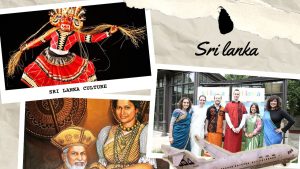Kandy, the cultural heart of Sri Lanka, is a city steeped in rich history and vibrant traditions. Once the capital of the ancient kings of Sri Lanka, Kandy has played a pivotal role in shaping the nation’s identity. Let’s look at the Places To Visit in Kandy, Sri Lanka. From 1592 to 1815, it was the last stronghold against colonial powers, symbolizing resistance and resilience.
Geographically, Kandy is nestled amidst rolling hills in the Central Province, making it a scenic gem. The city is built around a picturesque lake, which was created more than 200 years ago and adds to its serene beauty. Known for its religious significance, Kandy is home to the Temple of the Sacred Tooth Relic, a vital Buddhist site. The city’s unique blend of history, culture, and natural beauty makes it a must-visit destination in Sri Lanka.
Table of Contents
Best Time to Visit Kandy
The best time to visit Kandy, Sri Lanka, is from December to May. During these months, the weather is generally pleasant with an average temperature of 26 degrees Celsius, offering stable conditions for exploring the city.
This period is characterized by low rainfall and humidity, making it ideal for outdoor activities and sightseeing. Additionally, the famous Kandy Esala Perahara, a grand festival with processions, takes place in end of the July or August, offering a unique cultural experience. Travelers can enjoy the city’s natural beauty and cultural events comfortably during these months.
Accommodation Options
Kandy, Sri Lanka, offers a diverse range of accommodation options catering to all budgets and preferences. For luxury stays, hotels like The Grand Kandyan and Earl’s Regency provide opulent amenities and breathtaking views. The Cinnamon Citadel Kandy and Theva Residency, offering comfort and elegance at affordable prices.
Budget travelers can find great value at places like Queen’s Hotel and My City Hotel, which offer basic but comfortable amenities. These hotels and resorts are strategically located, providing easy access to Kandy’s main attractions, ensuring a pleasant stay for all types of travelers.
Top Attraction Places To Visit in Kandy
1. The Temple of the Sacred Tooth Relic
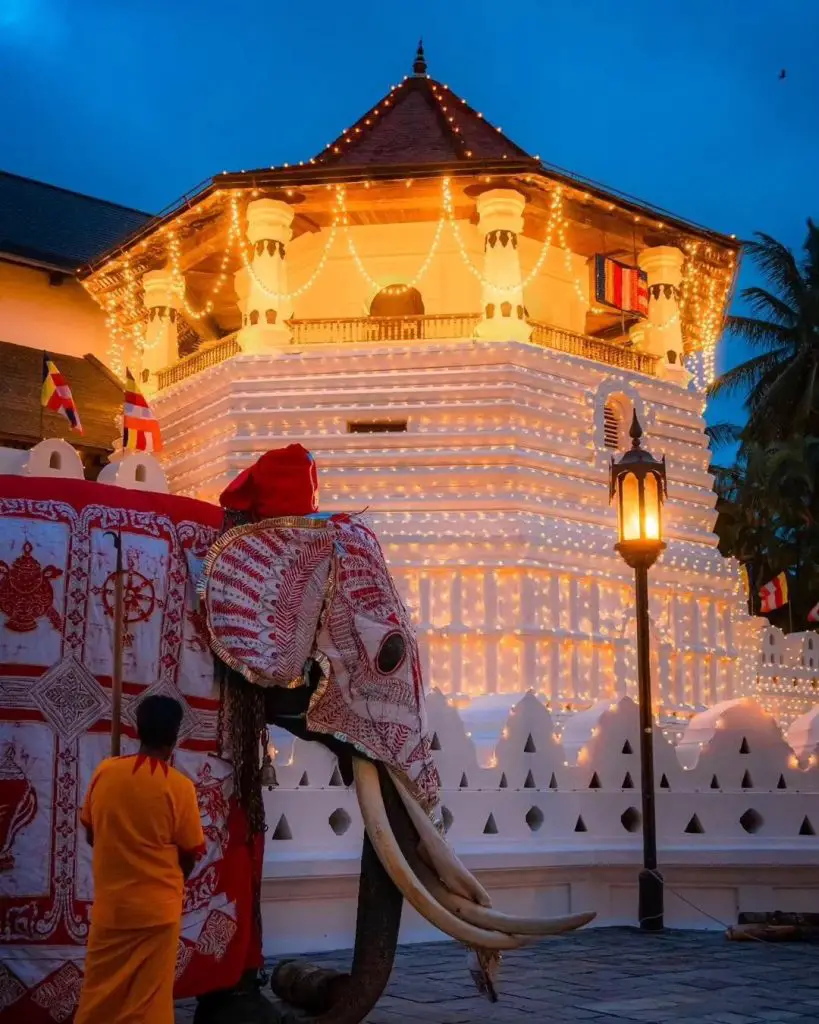
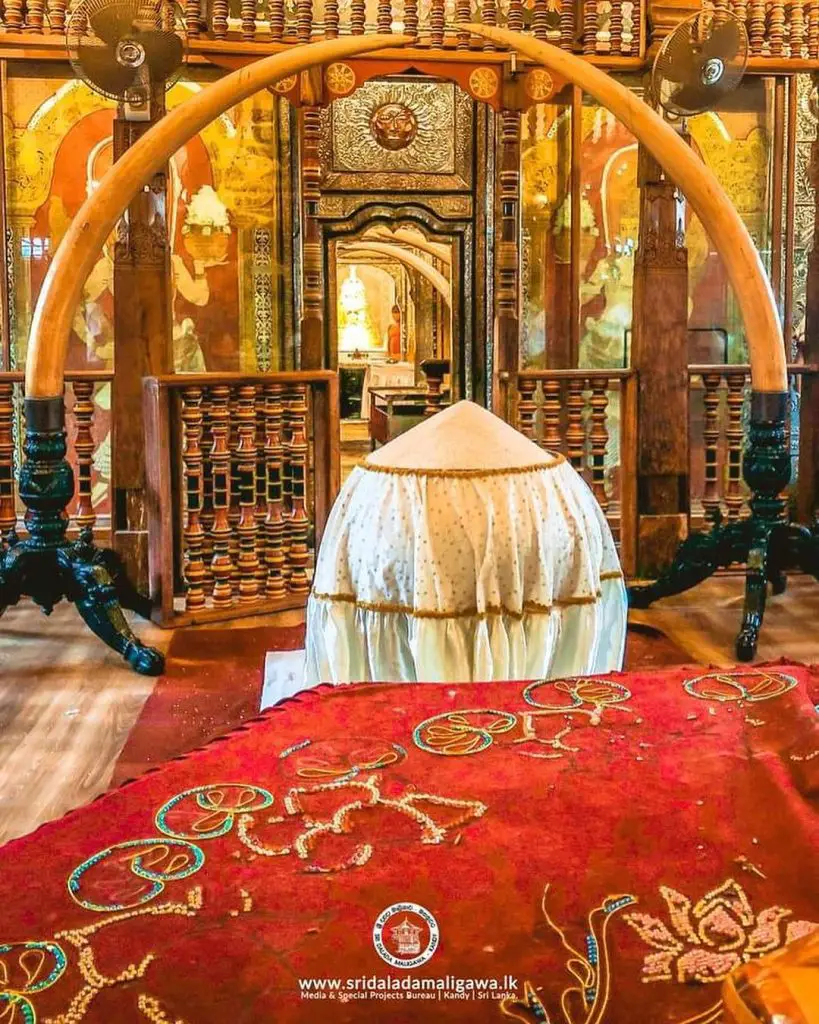
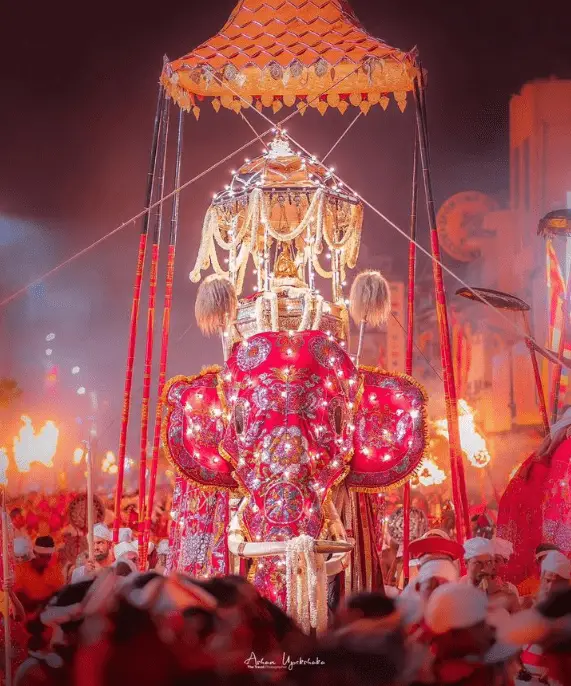
The Temple of the Sacred Tooth Relic is in the top of the list of Places To Visit in Kandy, also known as Sri Dalada Maligawa, is a profound symbol of Buddhism and a significant historical site located in Kandy, Sri Lanka. This article delves into the fascinating aspects of the temple, highlighting its religious, cultural, and architectural significance.
- A Sacred Relic: The temple is renowned for housing the sacred tooth of Buddha, believed to be his left upper canine. This relic is a symbol of sovereignty and is revered by Buddhists worldwide.
- Location: Situated in the picturesque city of Kandy, the temple is nestled amidst lush greenery, close to the scenic Kandy Lake.
- UNESCO World Heritage Site: Recognized for its historical and cultural value, the temple is a UNESCO World Heritage Site, attracting thousands of visitors annually.
- Architectural Splendor: The temple’s architecture is a blend of Kandyan, South Indian, and Indo-Chinese styles, characterized by intricate carvings and vibrant colors.
- Protective Rituals: Notable rituals include the Esala Perahera, a grand annual procession featuring elephants, dancers, drummers, and performers, aimed at safeguarding the sacred tooth relic.
- Historical Significance: Originally built in the 16th century by King Vimaladharmasuriya I, the temple has been a pilgrimage site for centuries.
- Gold Casket: The tooth relic is enshrined within a gold casket adorned with gemstones, placed in a decorated chamber.
- Annual Lighting Ceremony: Known as “Diyasalawa,” this event illuminates the temple with thousands of oil lamps, creating an ethereal atmosphere.
- Cultural Performances: Visitors can experience traditional Kandyan dancing, drumming, and devotional singing.
- World Tooth Relic Museum: The museum within the temple complex showcases artifacts related to the tooth relic’s history.
- Pilgrimage Destination: The temple is a major pilgrimage site for Buddhists globally.
- Ornate Decorations: During festivals, the temple is adorned with elaborate decorations and floral arrangements.
- The Sacred Tooth Relic Chamber: Known as “Handun Kunama,” this chamber is heavily guarded and accessible only to high-ranking monks and officials.
- Daily Rituals: Rituals include offerings of flowers, incense, and prayers, carried out by the temple’s custodians.
- Surrounding Temples: The complex includes several smaller temples and shrines with revered Buddhist statues and relics.
- Festivals and Celebrations: The temple is a hub of activity during religious festivals, with processions and traditional ceremonies.
- Relic Custodians: Known as “Dalada Maligawa Adikarana Nilame,” these custodians are responsible for the relic’s care and protection.
- Spiritual Aura: The temple offers a serene and peaceful atmosphere for contemplation and reflection.
- Global Pilgrims: It attracts visitors from various countries and religious backgrounds.
FAQs
- What is the Temple of the Tooth?
- A sacred Buddhist temple in Kandy, Sri Lanka, housing the tooth relic of Lord Buddha.
- Can visitors see the actual tooth relic?
- No, the tooth relic is not displayed publicly. It is kept in a series of nested golden caskets.
- Is photography allowed inside the temple?
- Photography inside the temple is generally prohibited, but external photography is allowed.
- What is the best time to visit the Temple of the Tooth?
- During the Kandy Esala Perahera festival in July or August, featuring a grand procession of the tooth relic.
- Is there an entrance fee for the temple?
- Yes, there is an entrance fee, varying for local and foreign visitors.
2. National Museum of Kandy
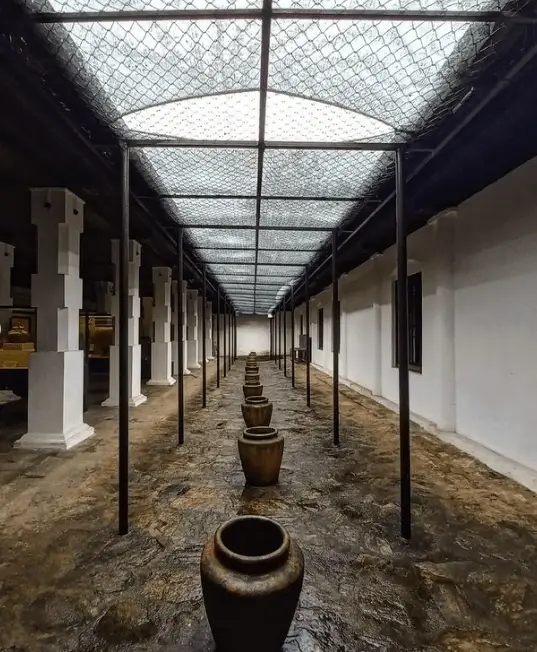
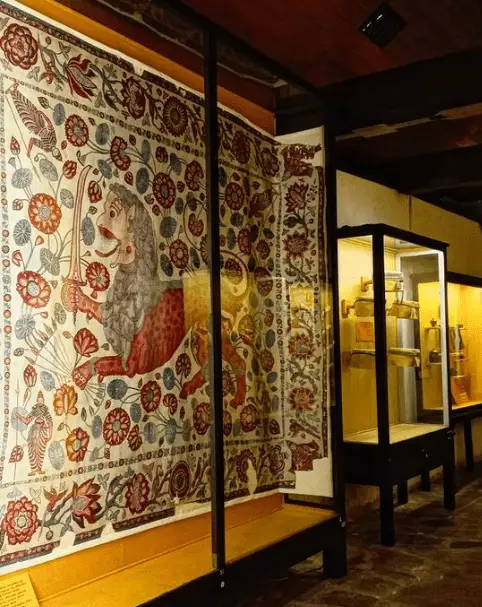
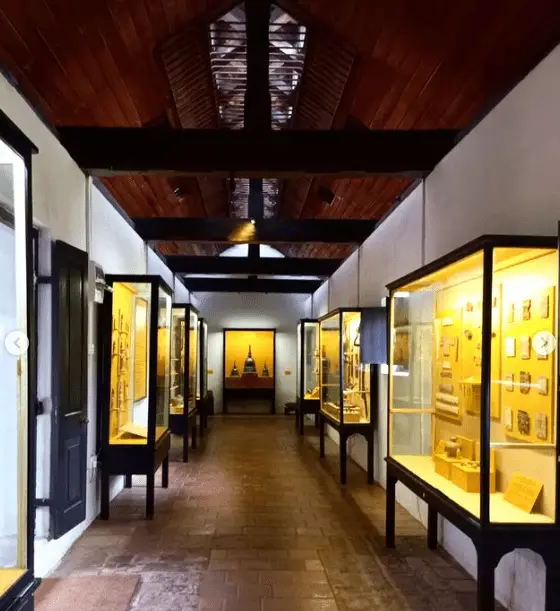
You Should add The National Museum of Kandy to the list of Places To Visit in Kandy, a significant historical and cultural institution in Sri Lanka, offers a deep dive into the rich heritage of the Kandyan era. Located adjacent to the renowned Temple of the Tooth within the former Royal Palace of Kandy, this museum stands as a testament to Sri Lanka’s vibrant past.
- Establishment and Location: Established in 1942, the National Museum of Kandy is situated in Kandy, Sri Lanka, next to the Temple of the Tooth, in part of the former Royal Palace of Kandy.
- Historical Buildings: The primary exhibits are housed in the Palle Vahala building, once the home of the King’s harem, and a secondary exhibition is located in the main palace building.
- Architectural Significance: The Palle Vahala, also known as Meda Vahala, was constructed during the Sri Vickrama Rajasingha era, reflecting the architectural features of the Kandy period.
- Artifacts and Exhibits: The museum boasts over 5,000 artifacts, including weapons, jewelry, tools from the Kandian era (17th-19th Century), and items from the post-British Colonial era.
- Historical Documents: Among its notable exhibits is a copy of the 1815 agreement that ceded the Kandyan provinces to the British.
- Statue of Sir Henry Ward: The museum grounds feature a statue of Sir Henry Ward, a former Governor of Ceylon (1855–1860), originally located in front of the Queen’s Hotel.
- Cultural and Educational Value: The museum serves as a repository of Kandy’s history and culture, providing educational insights into the region’s past.
FAQs
- What is the National Museum of Kandy?
- A museum in Kandy, Sri Lanka, showcasing artifacts and exhibits from the Kandyan era and the British Colonial period.
- Where is the National Museum of Kandy located?
- Next to the Temple of the Tooth in part of the former Royal Palace of Kandy.
- What can visitors see at the museum?
- Over 5,000 artifacts including weapons, jewelry, tools, and historical documents like the 1815 agreement with the British.
- What is the significance of the Palle Vahala building?
- It was the former home of the King’s harem and reflects the architectural style of the Kandy period.
- Is there a statue of historical significance on the museum grounds?
- Yes, a statue of Sir Henry Ward, a former Governor of Ceylon.
Suggestions | Read Now : 10 Unforgettable Things to Do in Galle, Sri Lanka: A Guide to History, Beaches, and Culture
3. Kandy View Point
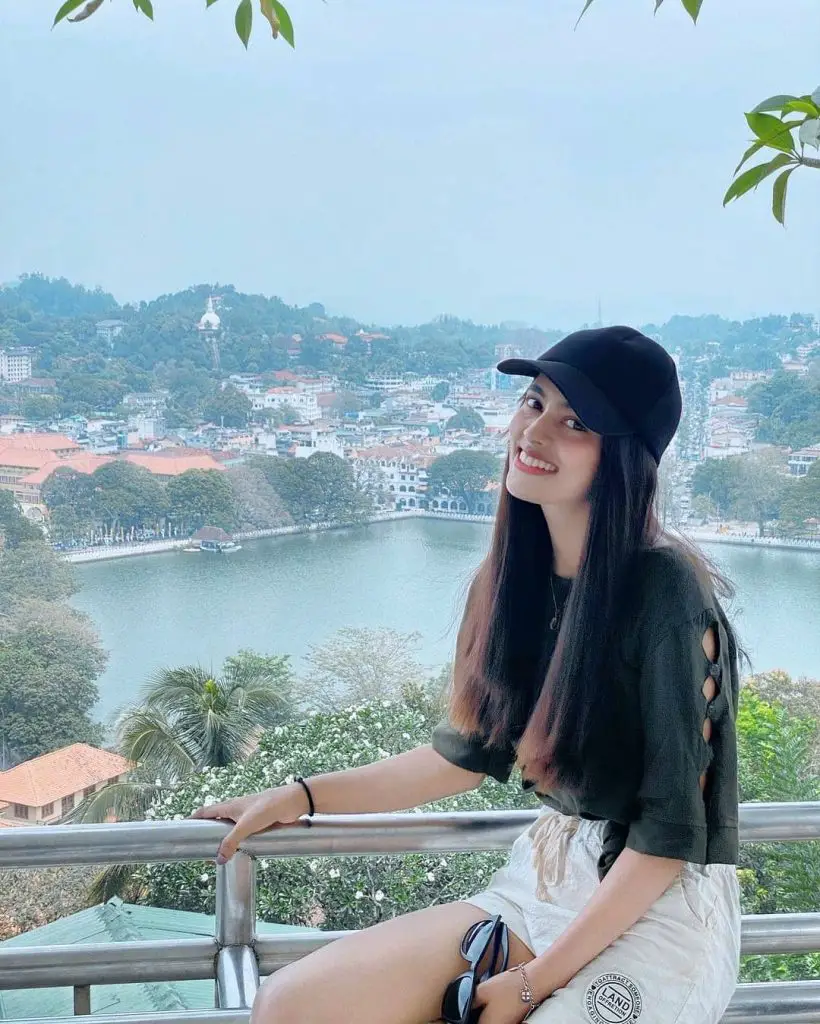
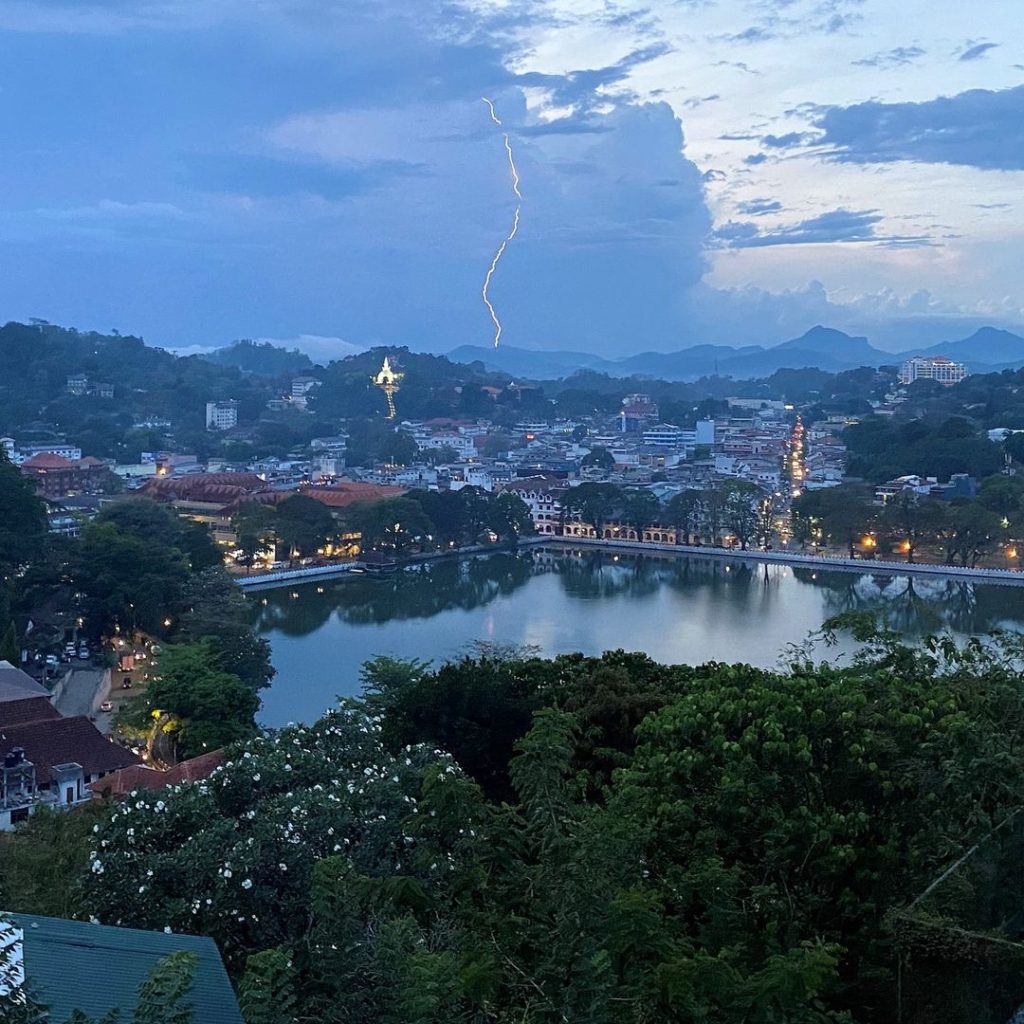
Kandy View Point is a popular tourist destination among Places To Visit in Kandy, Sri Lanka, known for its breathtaking views of the city and its surroundings. This viewpoint offers a unique perspective of Kandy’s natural beauty and is a must-visit for anyone traveling to the area.
- Location: Kandy View Point is situated on Rajapihilla Mawatha in Kandy, Sri Lanka.
- Popularity: It is ranked highly among tourist attractions in Kandy, known for its stunning panoramic views.
- Accessibility: The viewpoint is easily accessible and is a short walking distance from the city center.
- Views: Visitors can enjoy spectacular views of Kandy, including the Upper Lake and the cityscape.
- Ideal for Photography: It is a perfect spot for taking photographs, especially for capturing the beauty of Kandy and its lake.
- Visitor Experience: Tourists often find the view breathtaking, with some noting it as a highlight of their visit to Kandy.
- No Entrance Fee: As a public viewpoint, there is no charge for visiting Kandy View Point.
- Best Time to Visit: The viewpoint is ideal for visiting both during the day and in the evening to experience the full beauty of the city.
FAQs
- What is Kandy View Point?
- A popular viewpoint in Kandy, Sri Lanka, offering panoramic views of the city and its natural surroundings.
- Where is Kandy View Point located?
- On Rajapihilla Mawatha in Kandy, Sri Lanka.
- What can visitors see from Kandy View Point?
- Stunning views of Kandy city, including the Upper Lake and the surrounding landscape.
- Is there any fee to visit Kandy View Point?
- No, there is no entrance fee to visit the viewpoint.
- What is the best time to visit Kandy View Point?
- Both daytime and evening visits are recommended to experience the city’s beauty in different lights.
4. Peradeniya Botanical Gardens
The Peradeniya Botanical Gardens is also in the list of top Places To Visit in Kandy, a magnificent oasis of flora, is a must-visit for nature lovers in Sri Lanka. Located near Kandy, this botanical wonder spans about 60 hectares and boasts an extensive collection of over 4000 plant species.
- History: The gardens trace their roots back to the 14th century. Originally a royal garden in the 18th century, it was established for plant research in the 1820s.
- Floral Diversity: The garden is home to an array of plant species including a vast collection of orchids, palms, spices, and medicinal plants.
- Orchid House: One of the main attractions, featuring over 300 varieties of orchids.
- Memorial Trees: Trees planted by notable individuals, offering a unique historical perspective.
- Palm Collection: Among the best in Asia, featuring around 220 species.
- Scenic Beauty: Enveloped by the Mahawali River, the garden’s layout presents a picturesque landscape.
Visitor Experience
- Layout and Design: The garden is well-designed with spacious lawns, pavilions, and plant houses. Its layout provides a peaceful and immersive experience.
- Educational and Informative: The gardens serve as an educational resource, with information on various plant species and their uses.
- Family-Friendly: A great place to spend a day with kids, offering ample space for exploration and relaxation.
- Photography Opportunities: The vibrant flower gardens and unique plant species make for excellent photography.
Tips for Visitors
- Accessibility: Easily reachable by public transport or taxi from Kandy.
- Best Time to Visit: The gardens are lush throughout the year, with peak flowering seasons between April-June, August-September, and December.
- Facilities: On-site cafes are available for refreshments. Buggy carts and guided tours can be arranged.
- Admission Fee: As of recent reports, the entrance fee is around 2000 LKR per adult.
FAQs
- What are the operating hours of Peradeniya Botanical Gardens?
- The gardens are open daily, but it’s advisable to check current timings before visiting.
- Can I take guided tours of the gardens?
- Yes, guided tours are available, and they can provide in-depth knowledge about the flora.
- Is photography allowed in the gardens?
- Yes, photography is allowed, making it an ideal spot for nature photographers.
- Are there any specific rules or dress codes to follow?
- No specific dress code, but it’s recommended to dress comfortably for walking.
5. Ambuluwawa Tower
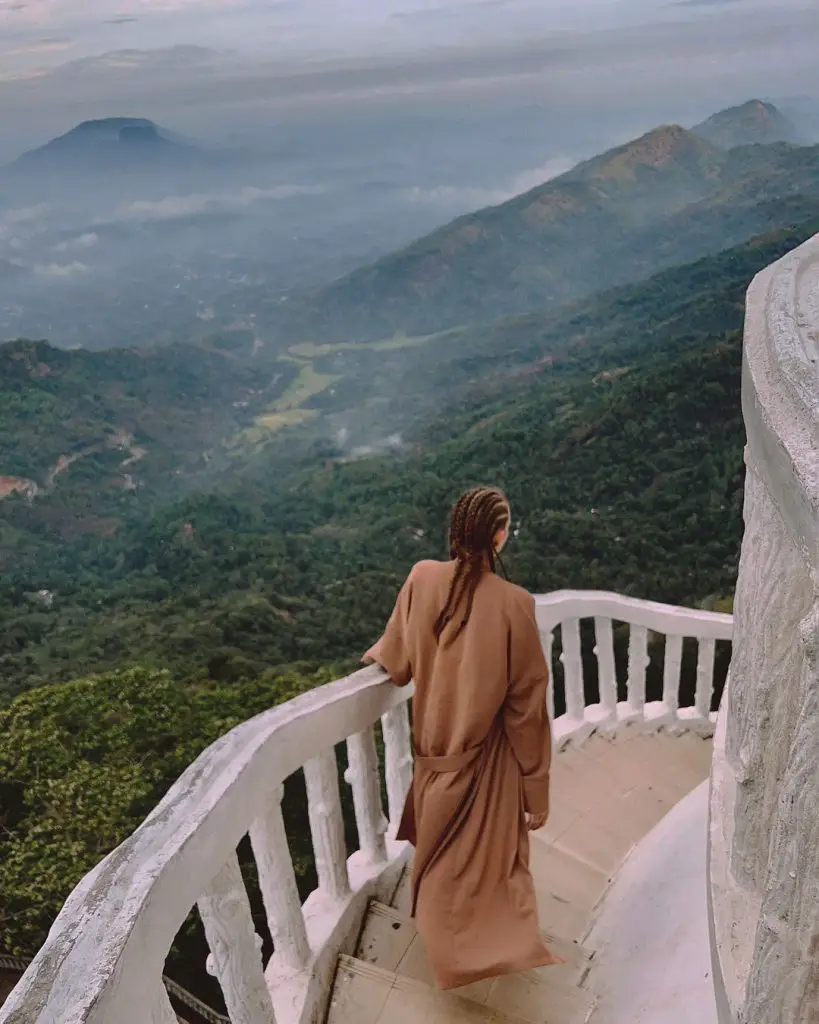
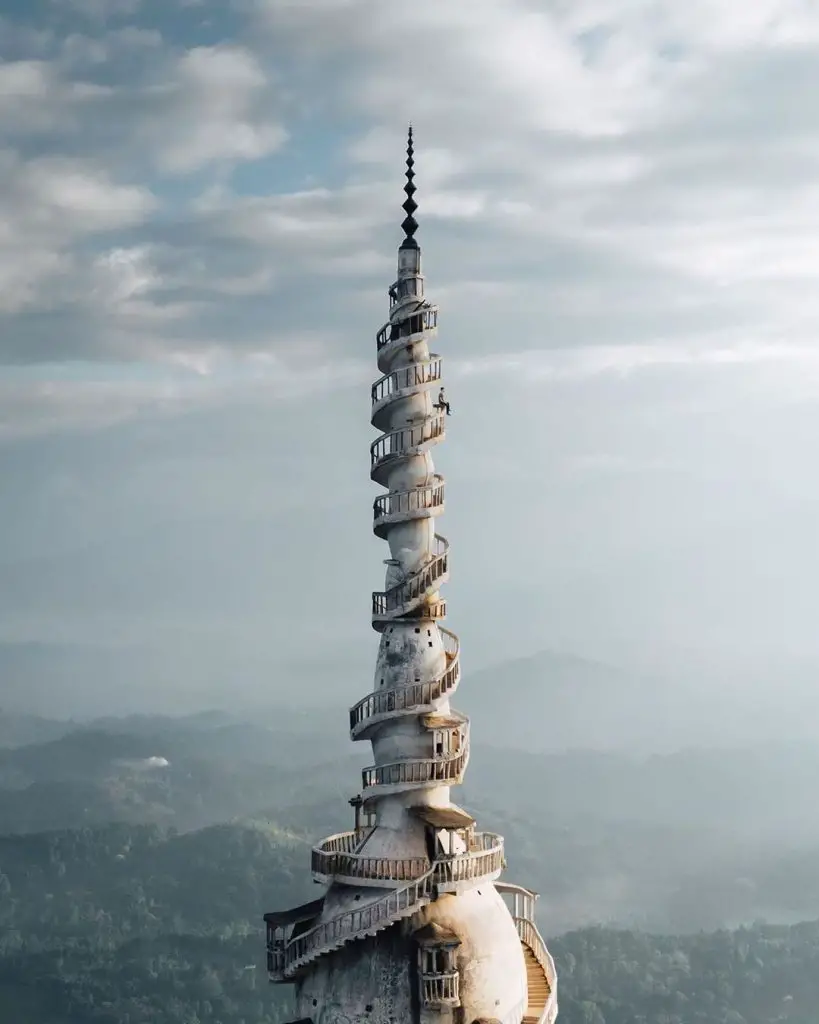
Ambuluwawa Tower is another must experience among Places To Visit in Kandy, located in the Ambuluwawa Biodiversity Complex near Gampola, is a unique and must-visit landmark in Sri Lanka. This complex, known as the country’s first multi-religious center, includes a Buddhist Stupa, a Christian Church, a Hindu Kovil, and a Muslim Mosque, symbolizing harmony and unity among different religions.
The tower itself is an architectural marvel, resembling the works of Gaudi, with a spiraling staircase that narrows as you ascend. Standing 48 meters (157.4 feet) high atop a mountain, it offers a breathtaking 360° view of the surrounding area. The climb to the top of the tower is an adventurous experience, taking about 10 to 15 minutes without stops. The staircase becomes increasingly narrow and challenging, providing an exhilarating experience, especially for those not afraid of heights.
To visit Ambuluwawa Tower from Kandy, you can take a bus or train to Gampola, which is about 25 km (15.5 mi) away. The journey from Kandy to Gampola by bus takes around an hour, and then you can hire a tuk-tuk to reach the tower. Alternatively, there is a train service from Kandy to Gampola, although it might take longer than the bus. Once in Gampola, you can either hike or take a tuk-tuk to the tower. The hike is about 6.1 km (3.8 mi) with an ascent of 576 m (1889 ft), but most visitors prefer the convenience of a tuk-tuk.
The best time to visit the tower is during the dry season from November to early April, and it’s recommended to go early in the morning to avoid crowds and enjoy cooler temperatures. The entrance fee for foreigners is 2,000 LKR, with an additional 100 LKR if taking a tuk-tuk to the entrance.
FAQs
- Can you drive to the top of Ambuluwawa Tower?
- Yes, you can drive to the top, but hiking is also an option for those seeking an adventurous experience.
- What is the best time to visit Ambuluwawa Tower?
- Early morning or late afternoon is recommended to avoid crowds and enjoy cooler temperatures.
- Is there a dress code for visiting Ambuluwawa Tower?
- There is no strict dress code, but respectful clothing is advised, especially when visiting the religious sites within the complex.
- Are there facilities available at Ambuluwawa Tower?
- Basic facilities are available, but it’s advisable to bring water and snacks, especially if you plan to hike.
6. Udawattekele Sanctuary
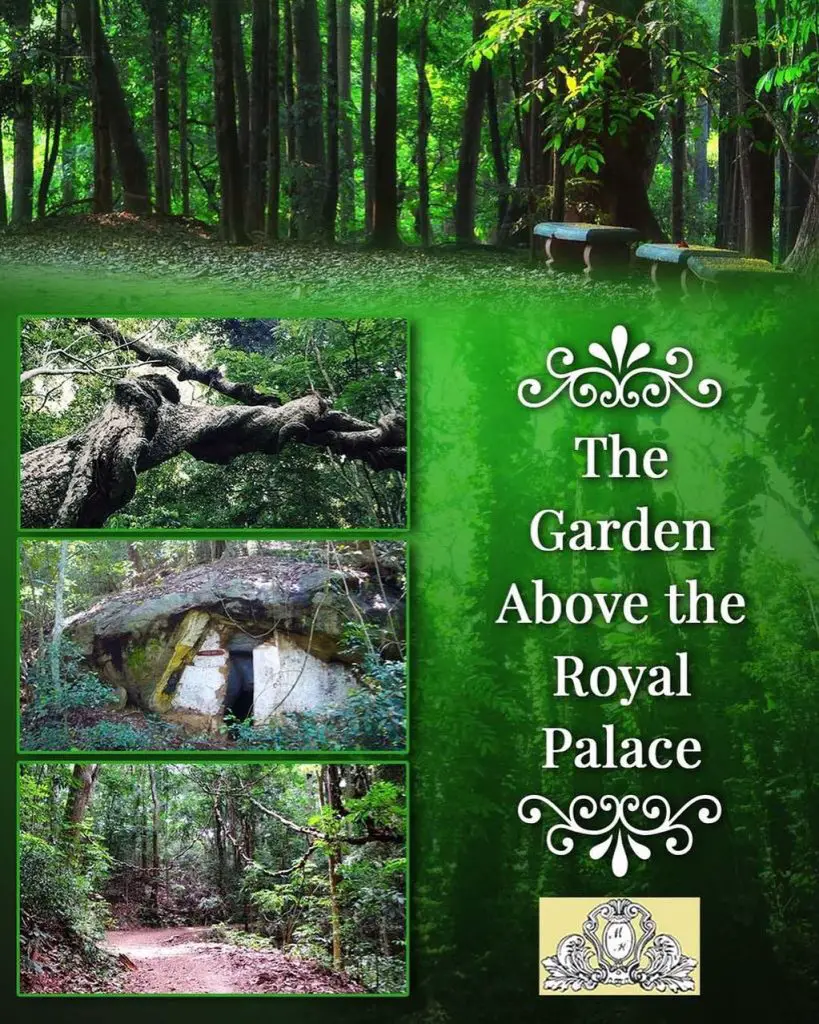
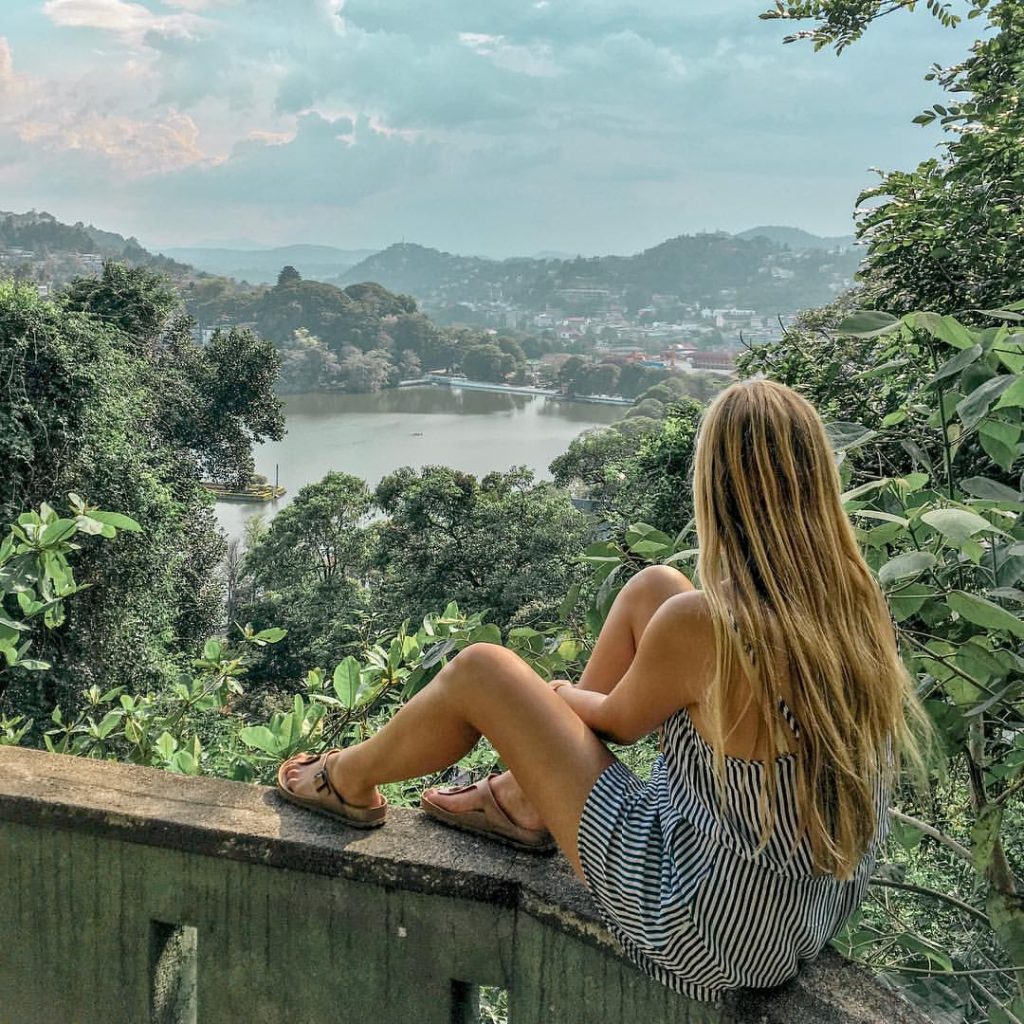
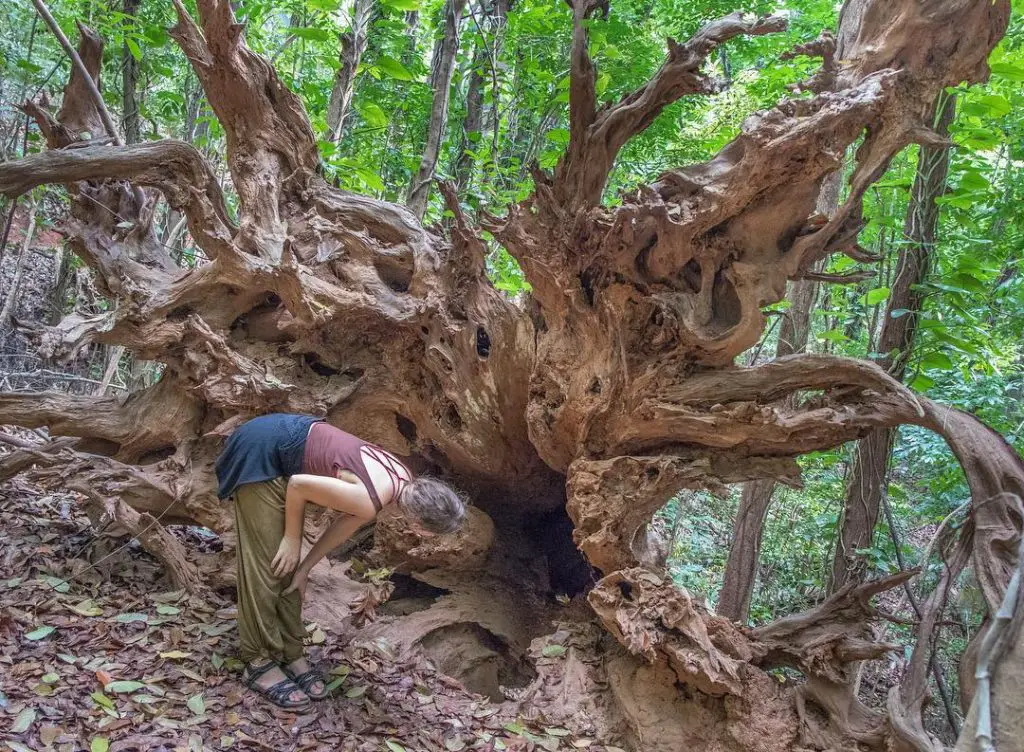
Udawattekele Sanctuary, also known as Udawattakele Forest Reserve, is a historic and ecologically significant area located in Kandy, Sri Lanka. This sanctuary, rich in biodiversity and cultural heritage, offers a serene escape in the heart of the city. If you hope to visit Kandy you can also add this place to the list of Places To Visit in Kandy
- Location and Size: Situated in the Central Province of Sri Lanka, within the city limits of Kandy, Udawattekele spans over 104 hectares (257 acres).
- Historical Significance: Originally known as “Uda Wasala Watta” in Sinhalese, meaning “the garden above the royal palace,” it served as a pleasure garden for Kandyan kings.
- Flora and Fauna: The sanctuary is home to a diverse range of plant species, including lianas, shrubs, and small trees, as well as a variety of mammals, reptiles, and birds.
- Avifauna: Udawattekele is renowned for its extensive birdlife, making it a popular spot for bird watchers.
- Educational Value: The forest houses a nature education center and is frequently visited by school groups and students for educational purposes.
- Buddhist Significance: The forest contains three Buddhist meditation hermitages and rock shelter dwellings for Buddhist monk hermits.
- Accessibility: Visitors can enter the sanctuary from the western side, about 15-20 minutes walking from the Temple of the Tooth.
- Entrance Fee: There is a nominal entrance fee, with different rates for Sri Lankan and foreign visitors.
FAQs
- What is Udawattekele Sanctuary?
- A historic forest reserve and sanctuary located in Kandy, Sri Lanka, known for its rich biodiversity and cultural significance.
- What can visitors see in Udawattekele Sanctuary?
- A variety of plant species, wildlife including birds, mammals, and reptiles, and Buddhist hermitages.
- Is Udawattekele Sanctuary accessible to tourists?
- Yes, it is easily accessible from the city center of Kandy and open to visitors.
- Are there any educational facilities in the sanctuary?
- Yes, there is a nature education center within the sanctuary.
- Is there an entrance fee for Udawattekele Sanctuary?
- Yes, there is a nominal entrance fee with different rates for local and foreign visitors.
7. Ceylon Tea Museum
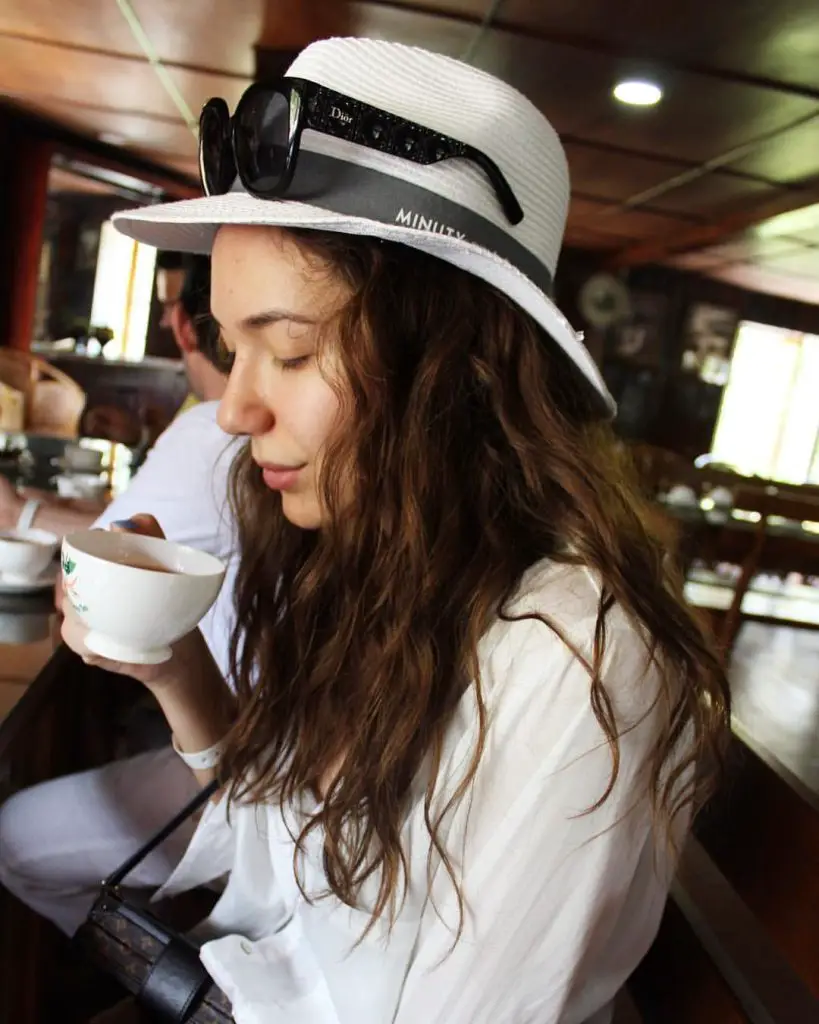
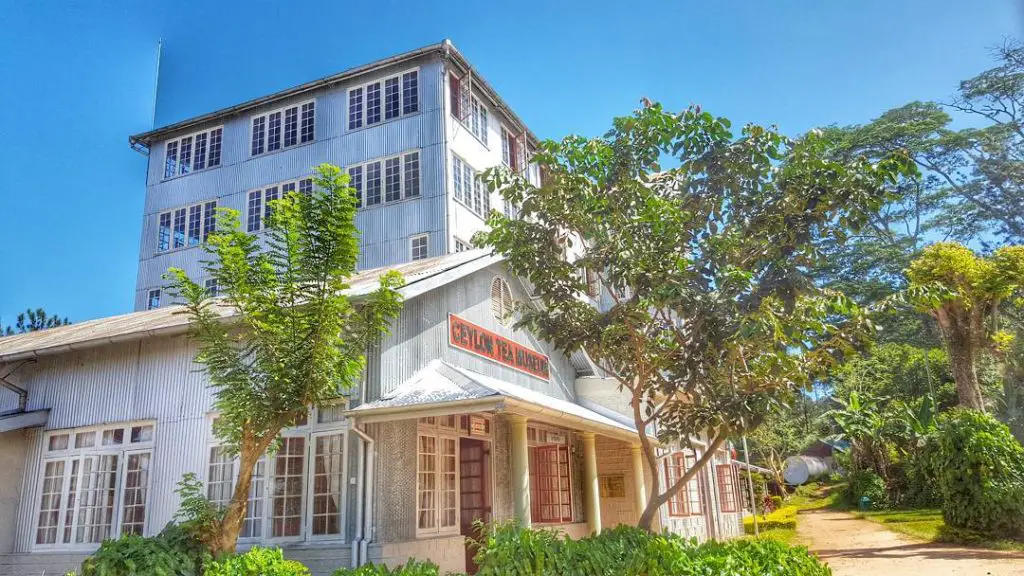
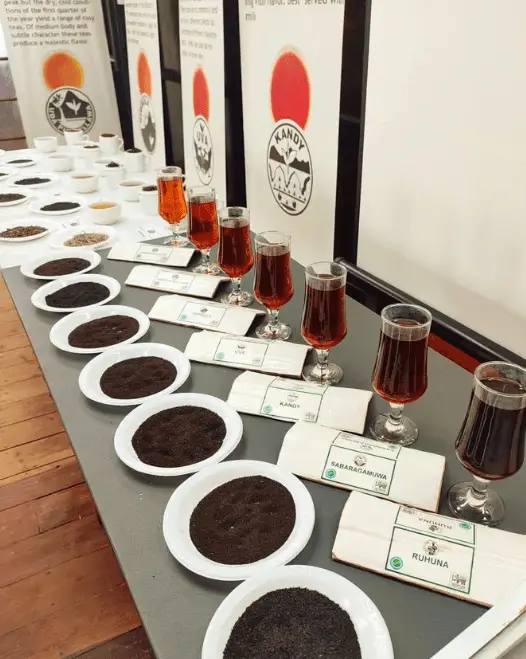
The Ceylon Tea Museum, a significant historical and cultural site, is located in the former Hanthana Tea Factory, which dates back to 1925. If you are interested in tea this place is also must in your list of Places To Visit in Kandy, Sri Lanka. It’s Situated in the picturesque area of Hanthana, near Kandy, Sri Lanka, this museum offers a unique insight into the rich history of tea production on the island.
- Establishment: The Ceylon Tea Museum was established on 1 December 2001.
- Location: It is located in Hanthana, Kandy, Sri Lanka, approximately 3 km south of Kandy.
- Historical Background: Hanthana was one of the first successful areas for tea cultivation after the failure of coffee production in Sri Lanka.
- Building’s History: The museum is housed in a four-storey tea factory that had been abandoned for over a decade before its refurbishment in 2001 by the Sri Lanka Tea Board and the Planters’ Association of Sri Lanka.
- Exhibits: The museum showcases exhibits on tea pioneers like James Taylor and Thomas Lipton, and features vintage tea-processing equipment.
- Facilities: The ground floor houses 19th-century colonial generators, rollers, dryers, and other machinery. The second floor contains the library and museum, the third floor has a shop, and the top floor features a restaurant and tea rooms.
- Educational Value: The museum serves as an educational resource, providing insights into the history and evolution of tea production in Sri Lanka.
FAQs
- What is the Ceylon Tea Museum?
- A museum dedicated to the history of tea production in Sri Lanka, located in the former Hanthana Tea Factory.
- Where is the Ceylon Tea Museum located?
- In Hanthana, near Kandy, Sri Lanka.
- What can visitors learn at the Ceylon Tea Museum?
- The history of tea production in Sri Lanka, information about tea pioneers, and the process of tea making.
- What are the features of the museum building?
- A four-storey building with historical tea-processing equipment, a library, a museum, a shop, and a restaurant.
- Is there an entrance fee for the Ceylon Tea Museum?
- Information about the entrance fee is not provided, but most museums have a nominal entrance fee.
8. Lankatilaka Vihara Temple
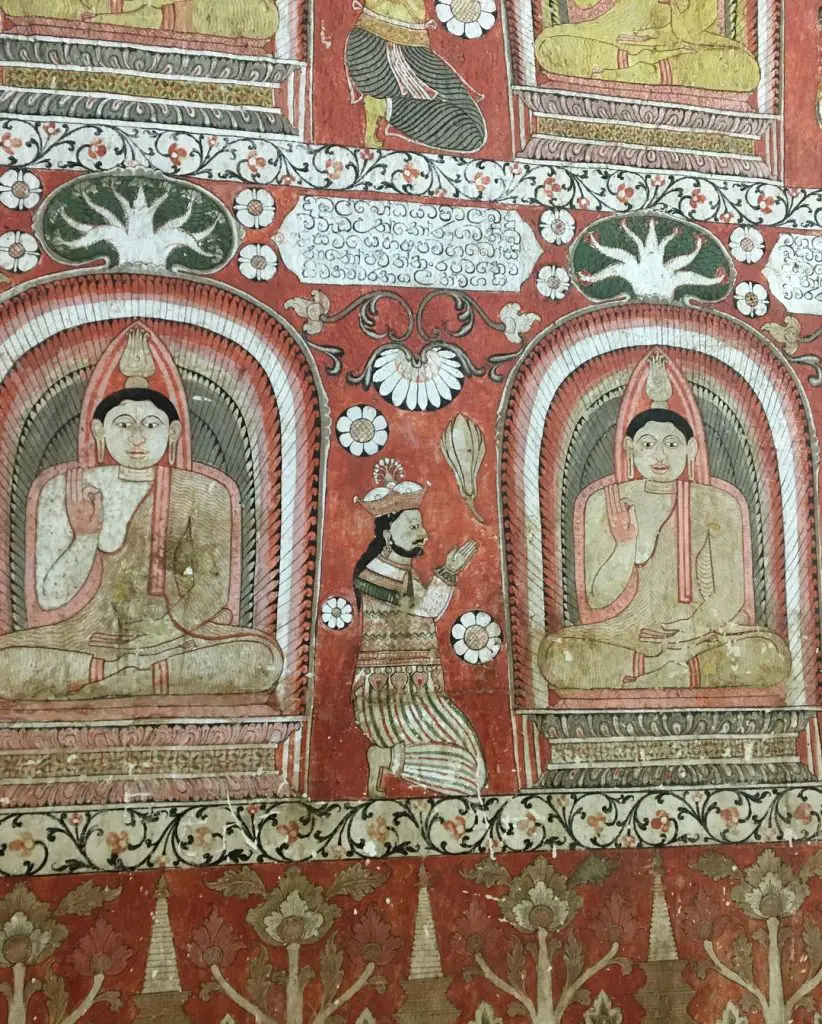
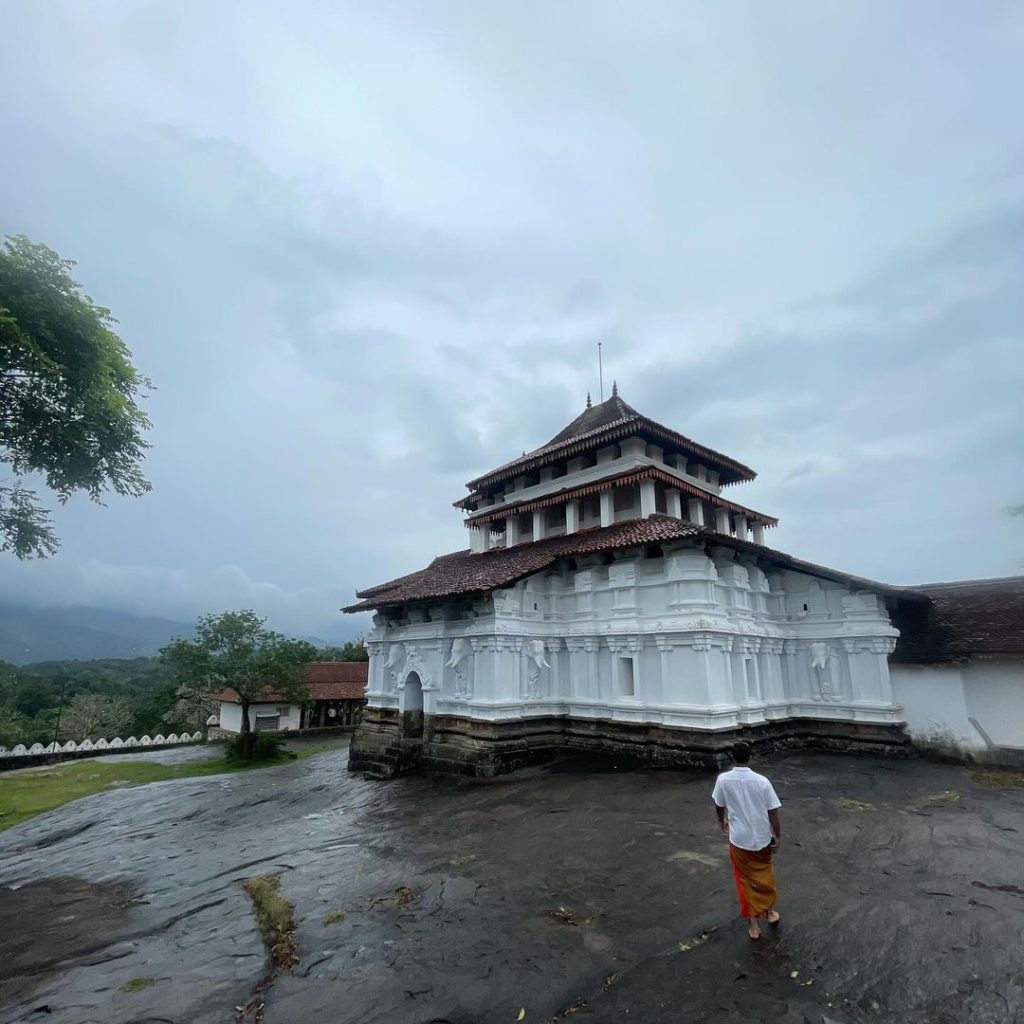
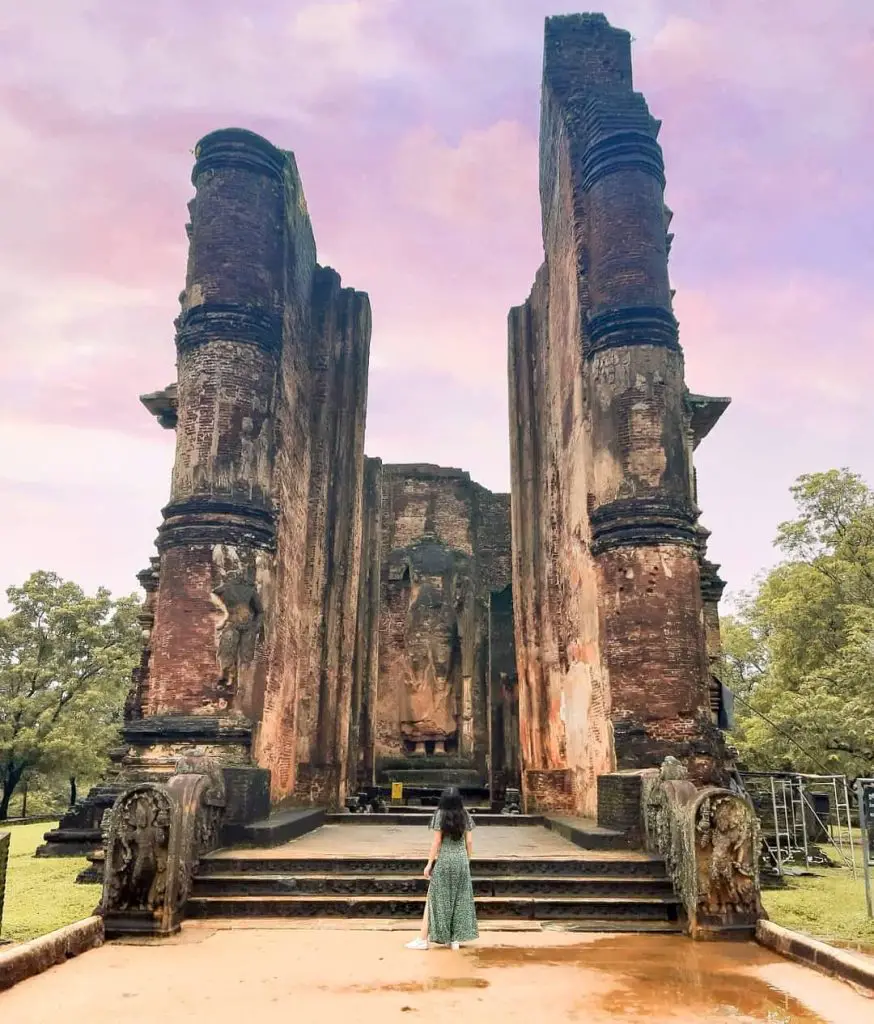
Lankatilaka Vihara is a revered and ancient Buddhist temple located in the medieval city of Polonnaruwa, Sri Lanka. It’s another good place if you are looking for Places To Visit in Kandy. Known for its unique architectural style and historical significance, this temple is a prominent example of the country’s rich cultural heritage.
- Historical Significance: Lankatilaka Vihara was built during the reign of Parakramabahu (1153-1186) and later restored by Vijayabahu IV (1513-1521).
- Location: The temple is situated in the Hiyarapitiya village, from the Udu Nuwara area of the Kandy district in Sri Lanka.
- Architectural Design: The temple was designed by the architect Sathapati Rayar, combining Sinhalese architecture from the Polonnaruwa era with Dravidian (Indian) and Indo-Chinese architectural patterns.
- Structural Features: Originally a four-story structure standing 80ft high, only three stories remain today. The temple is built on a natural rock with a granite base.
- Artistic Embellishments: The temple is adorned with beautiful arches, sculptures, and inscriptions in both Sinhala and Tamil on the solid rock, detailing the temple’s history and contributions from various kings.
- Current State: Today, Lankatilaka Vihara is known for its stunning architecture and craftsmanship, including a Moonstone or ‘Sandakadapahana’ at the entrance, and two iconic lion paintings.
- Buddha Statue: The temple houses a striking statue of the Seated Buddha, sheltered by a Dragon Arch, surrounded by designs of trees and flowers, and walls adorned with paintings depicting the lives of the twenty-four previous Buddhas.
FAQs
- What is Lankatilaka Vihara Temple?
- An ancient Buddhist temple in Polonnaruwa, Sri Lanka, known for its unique architectural style and historical significance.
- Who built Lankatilaka Vihara Temple?
- It was built during the reign of Parakramabahu and restored by Vijayabahu IV.
- What are the architectural features of Lankatilaka Vihara Temple?
- A blend of Sinhalese, Dravidian, and Indo-Chinese architecture, originally a four-story structure with intricate sculptures and inscriptions.
- What can visitors see at Lankatilaka Vihara Temple today?
- Visitors can admire the temple’s architecture, the Moonstone at the entrance, the Seated Buddha statue, and historical paintings.
- How to reach Lankatilaka Vihara Temple?
- The temple is accessible from Colombo in around 3 hours 20 minutes by car, turning off at Pilimatalawa and covering a short distance of around 4km.
10. Horton Plains National Park
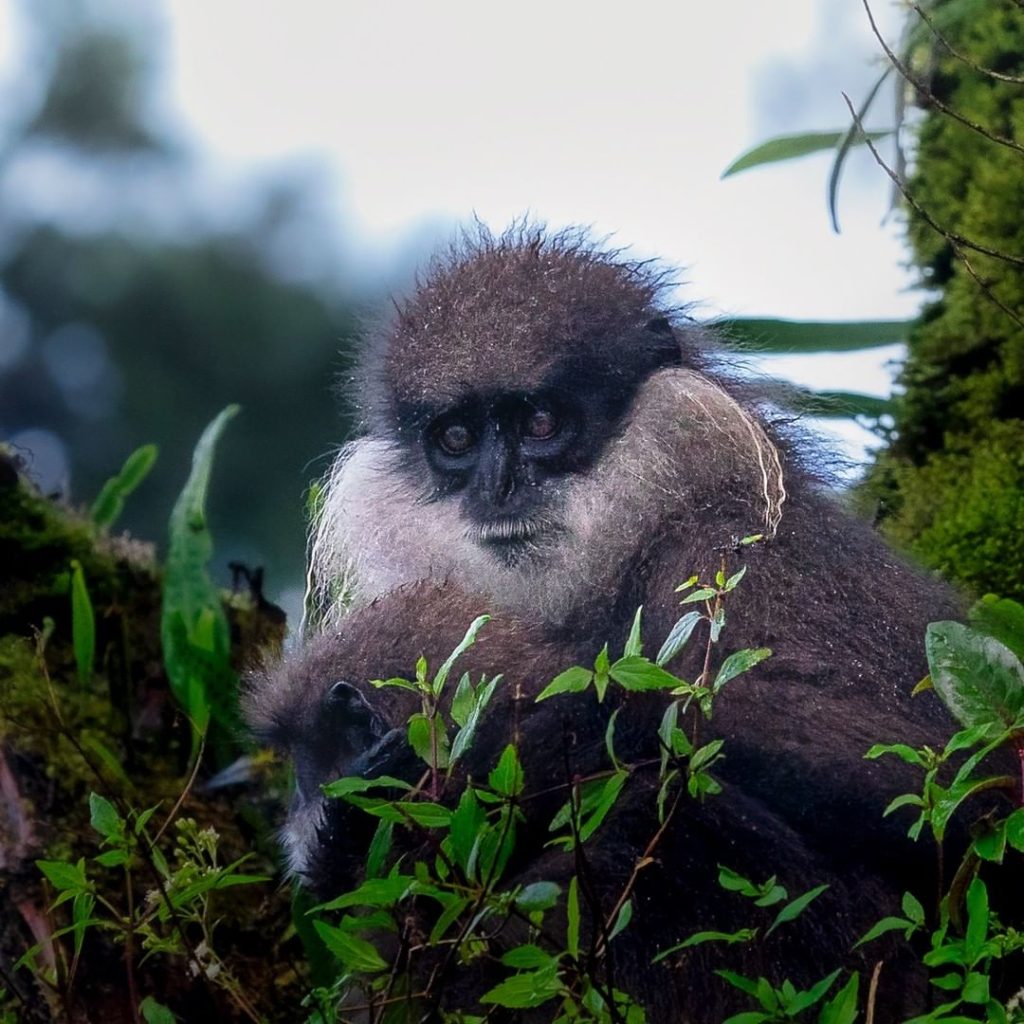
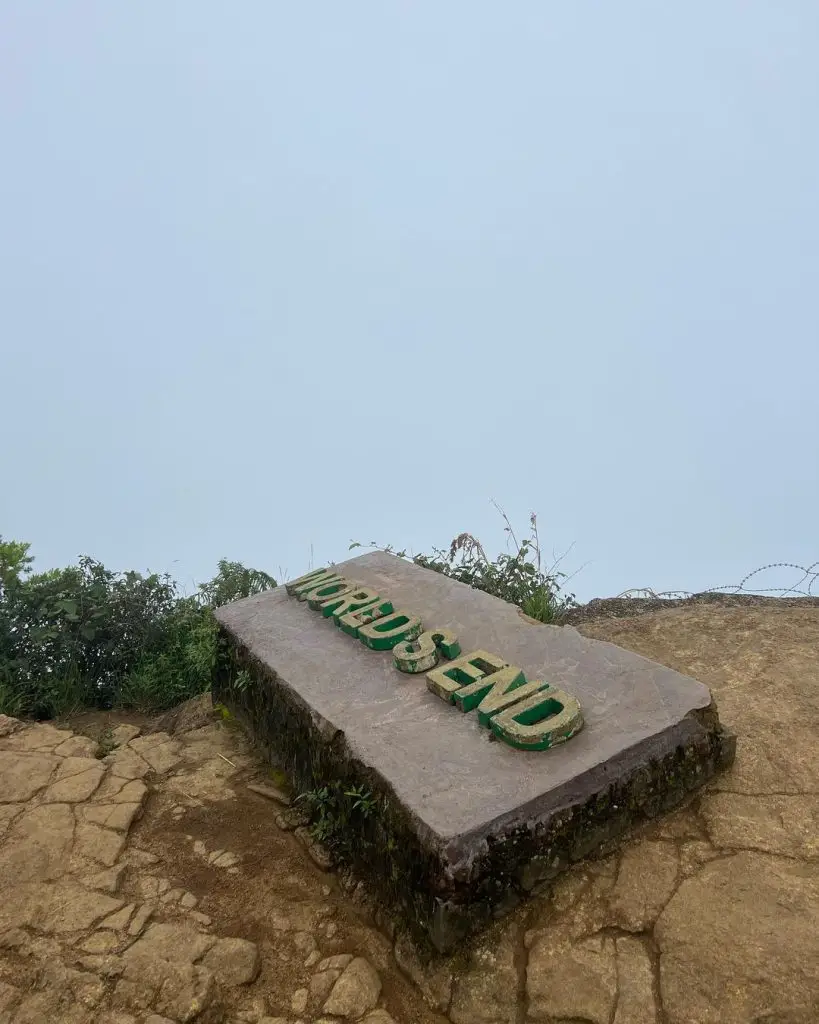
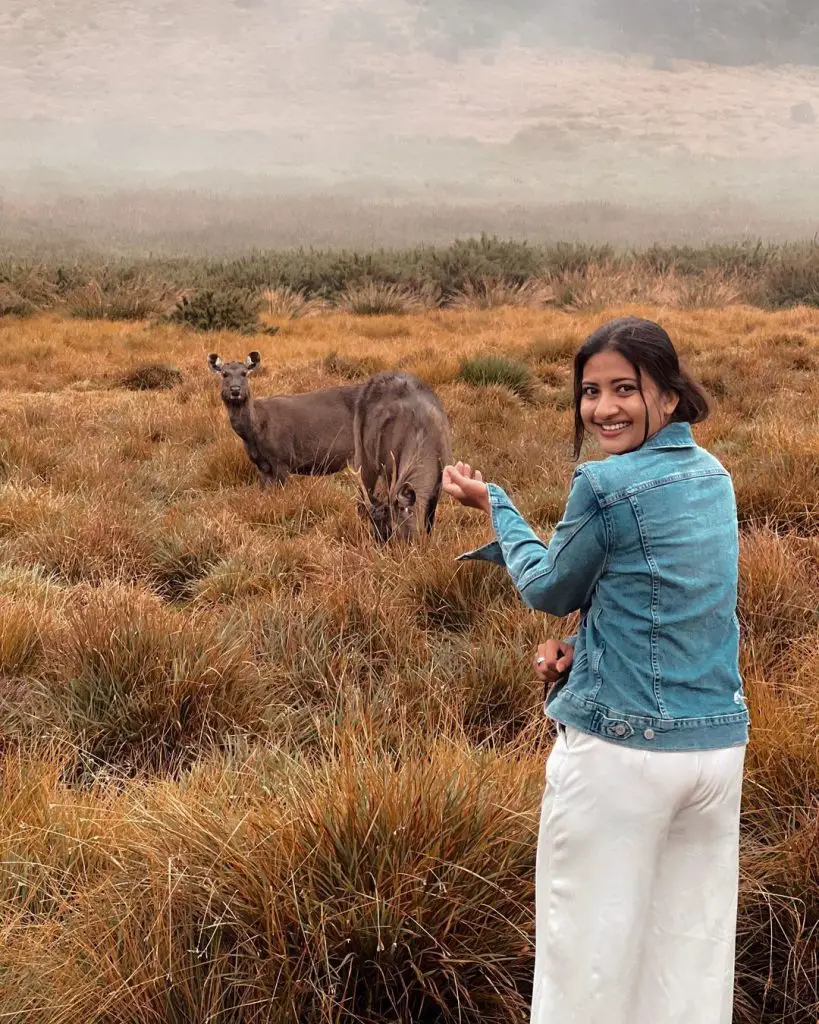
Horton Plains National Park, located in the central highlands of Sri Lanka, is a unique natural attraction known for its rich biodiversity and stunning landscapes. Include it as a must visit destination in your list of Places To Visit in Kandy
- Location and Size: Horton Plains is situated in the central highlands of Sri Lanka, covering an area of approximately 3,160 hectares.
- Ecosystem and Biodiversity: The park is characterized by montane grasslands and cloud forests and is home to a wide range of flora and fauna, some of which are endemic to the region.
- Famous Attractions: The park is renowned for World’s End, a sheer cliff with a dramatic drop of about 880 meters, offering breathtaking views. Another notable feature is Baker’s Falls, a picturesque waterfall.
- Climate: The area experiences a mild climate, with temperatures that can vary significantly during the day.
- Flora and Fauna: Horton Plains hosts a variety of plant species, including dense forests, ferns, and flowering plants. The park is also home to many species of birds, mammals, and reptiles.
- Conservation Status: It is a protected area and was designated as a national park in 1988. Horton Plains is also a key part of the Central Highlands of Sri Lanka, which is a UNESCO World Heritage Site.
- Hiking and Trekking: The park offers excellent opportunities for hiking and trekking, with well-marked trails leading to its main attractions.
- Visitor Information: The park is accessible to visitors, but it is advisable to check for any specific visitor guidelines or restrictions before planning a visit.
FAQs
- What is Horton Plains National Park known for?
- Horton Plains is known for its unique ecosystem, World’s End, and Baker’s Falls.
- What type of wildlife can be seen in Horton Plains?
- The park is home to a variety of wildlife, including endemic bird species, mammals like the sambar deer, and various reptiles.
- Is Horton Plains suitable for hiking?
- Yes, it offers excellent hiking trails with scenic views and diverse flora and fauna.
- What is the best time to visit Horton Plains?
- The best time is usually the early morning when the weather is clearer and the views are unobstructed.
- How do I get to Horton Plains National Park?
- The park is accessible by road, but the exact route may depend on your starting location in Sri Lanka.
11. Huluganga Falls
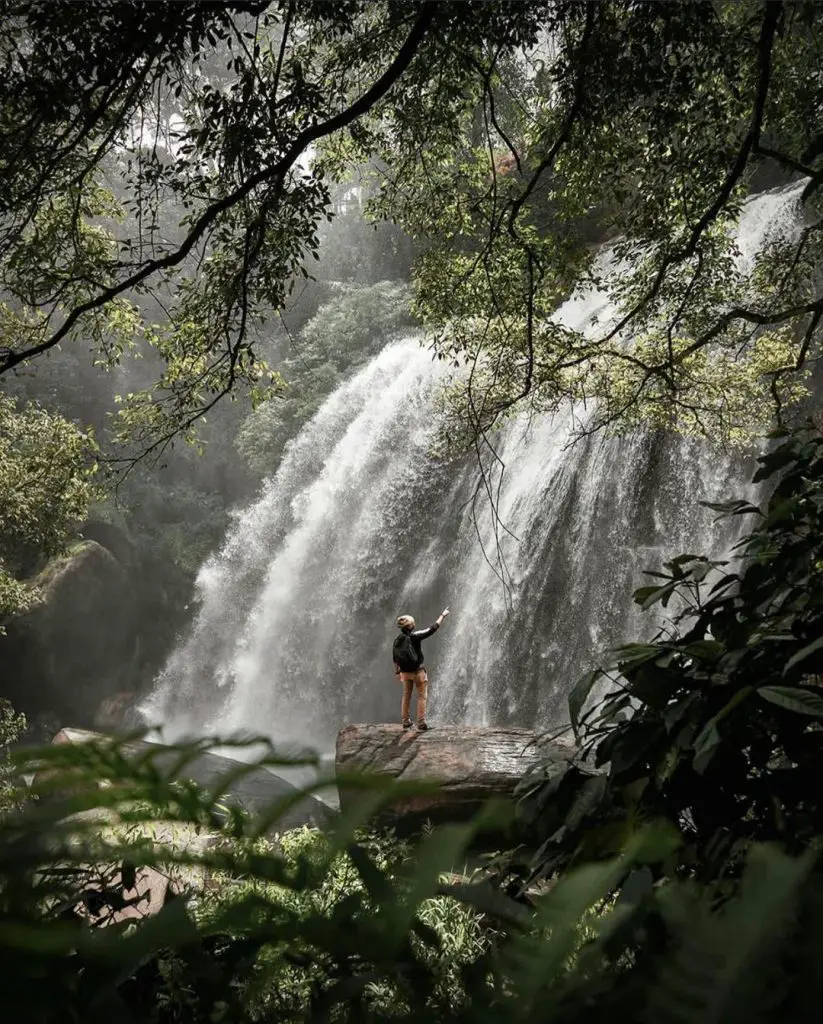
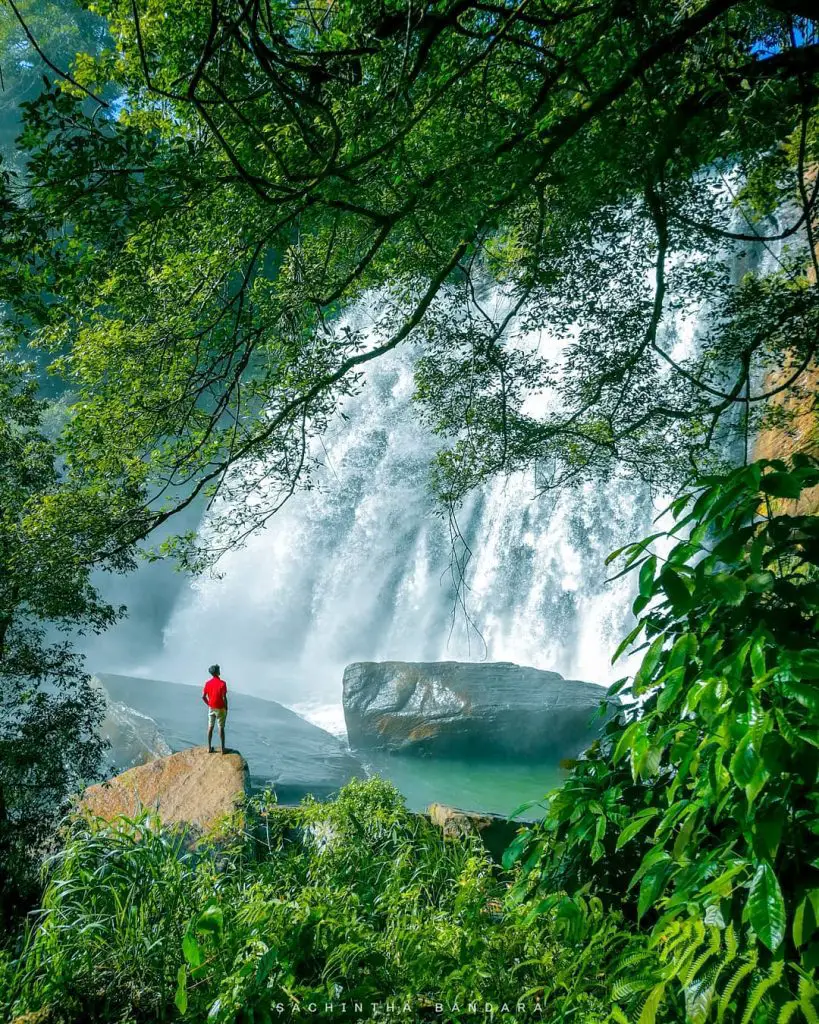
Huluganga Falls, located in Sri Lanka, is a captivating destination known for its natural beauty and cultural significance. When making your Kandy tour plan his place is another destination in Places To Visit in Kandy. Here’s an overview of what you need to know about this stunning waterfall:
- Location: Huluganga Falls is situated in the Kandy District, about 30 kilometers from Kandy Town, along the way to Bambarella. The waterfall forms part of the Hulu River, which originates from the Knuckles Mountain Range.
- Physical Features: The waterfall is approximately 75 meters in height. It’s known for its clear waters, which are kept unpolluted due to the presence of rocks, grass, and plants along the river. Despite variations in weather, the waterfall maintains its beauty throughout the year.
- Cultural Importance: Huluganga Falls is not just a natural wonder but also holds cultural value for the local communities. It was featured as a primary location in the popular teledrama “Ella Langa Walauwa” (Mansion by the Fall), enhancing its fame.
- Accessibility and Viewing Points: There are two main routes to reach the waterfall – Theldeniya – Rangala road and Wattegama to Bambarella. The waterfall is accessible throughout the year, even during the dry season. A staircase has been built on the right-hand side of the waterfall to facilitate viewing, but it limits the viewing angles for photography. There’s an entrance fee of 30 Rupees to access the staircase and the viewpoint. The waterfall’s location under the Huluganga Bridge and the construction of a dam near the top of the fall under the Kundasale Water Supply Scheme are notable aspects that influence its current state and viewing experience.
- Activities and Restrictions: Visitors can engage in activities like photography, nature trails, and waterfall hunting. However, bathing and washing clothes near the waterfall are restricted to preserve its natural beauty.
- Environmental Considerations: Environmentalists have raised concerns about the space between the dam and the fall, which may affect the flow of water.
FAQs
- What is the best time to visit Huluganga Falls?
- Huluganga Falls can be visited throughout the year. However, the best time is during the rainy season when the waterfall is at its fullest and most beautiful.
- How do I get to Huluganga Falls?
- There are two main routes: Theldeniya – Rangala road and Wattegama to Bambarella. From Colombo, you can travel via Peradeniya to Madawala and then to Bambarella Rd, Huluganga. The travel time from Colombo is approximately 4.5 hours. From Kandy, take the Katugastota – Madawala – Bambarella Road to reach Huluganga town.
- Is there an entrance fee?
- Yes, there’s an entrance fee of 30 Rupees to access the staircase and the viewpoint.
- Can I swim or bathe in the waterfall?
- No, bathing and washing clothes near the waterfall are restricted to protect its natural beauty.
- Are there any accommodations nearby?
- Yes, there are various accommodations ranging from budget to luxury options near Huluganga Falls, particularly in the nearby town of Kandy.
- Is the waterfall suitable for photography?
- Yes, Huluganga Falls is a popular spot for photography. However, due to the construction of a staircase, it offers limited camera angles.
- What other activities can I do around Huluganga Falls?
- Activities include photography, nature trails, and exploring other waterfalls along the Bambarella road.
- Is there any cultural significance of Huluganga Falls?
- Yes, the waterfall gained popularity as a location for the teledrama “Ella Langa Walauwa” and is regarded as part of the local heritage.
- Are there any environmental concerns regarding Huluganga Falls?
- Environmentalists have pointed out issues related to the dam built near the top of the waterfall, which might affect the water flow.
- What should I keep in mind when visiting Huluganga Falls?
- Respect the natural environment, adhere to the no-bathing rule, and be cautious while exploring the area, especially during rainy seasons when paths might be slippery.
12. Bahiravokanda Vihara Buddha Statue
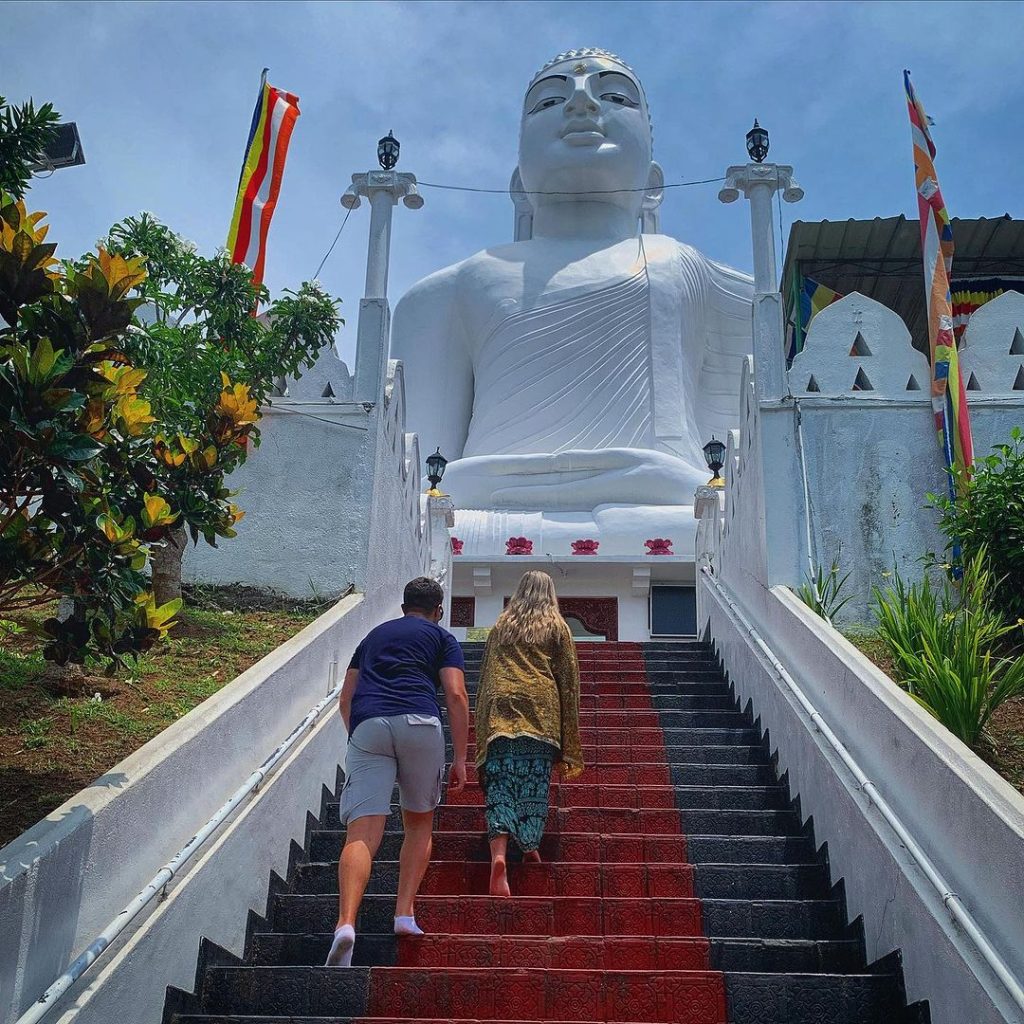
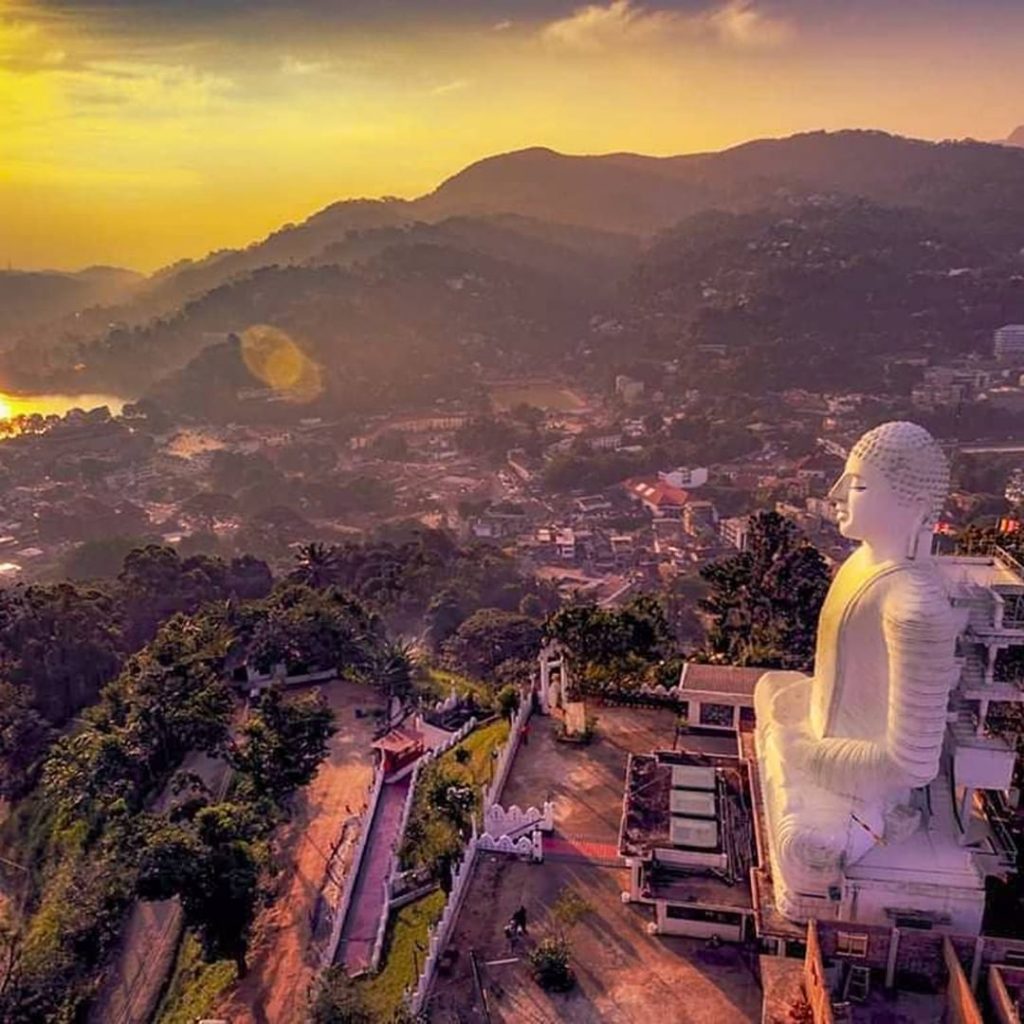
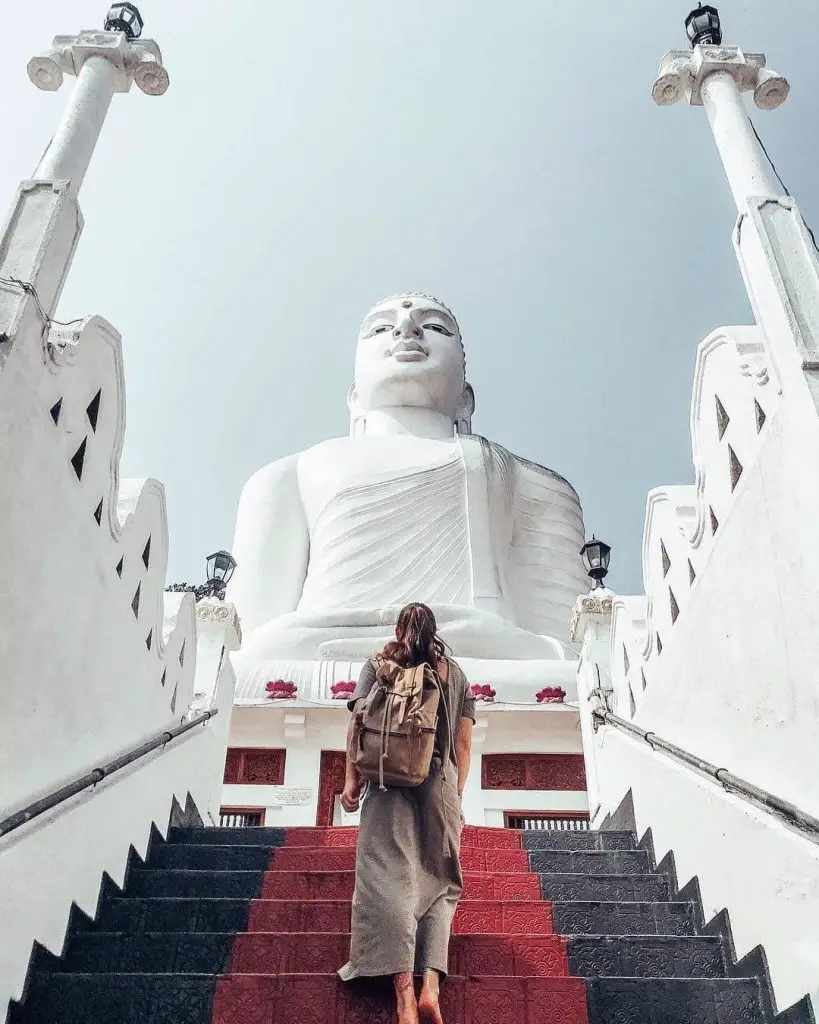
The Bahiravokanda Vihara Buddha Statue, a renowned landmark in Kandy, Sri Lanka, is celebrated for its majestic size and cultural significance. If you hope to stay Kandy in long trip it’s another good destination to be added to the Places To Visit in Kandy
- Height and Visibility: The statue stands at an impressive height of 88 feet, making it one of the largest Buddha statues in South Asia. It is visible from various points in Kandy city.
- Location: Positioned on Bahirawakanda hill, the statue is approximately 2 kilometers from Kandy’s center, offering a panoramic view of the city and surrounding mountains.
- Construction: Initiated in 1972, the white statue portrays Buddha in a seated Nirvana posture. The temple associated with the statue is Sri Maha Bodhi Viharaya.
- Accessibility: Visitors can access the site by climbing a hill, which involves a steep trek. A set of stairs behind the statue allows for ascending to higher vantage points.
Historical and Cultural Background
- Inception: The idea for the statue and temple was conceived by Ven. Ampitiye Dharmarama Thero in 1973, with completion in January 1993.
- Folklore: The hill, Bahirawa Kanda, translates to “Gnome Mountain,” and is associated with various local legends and folklore, enriching its cultural significance.
Visitor Experience
- View: Climbing to the top offers awe-inspiring views of Kandy and its surroundings, including notable sites like Bogambara Prison.
- Worship and Etiquette: The temple is a place of worship. Visitors should remove hats and shoes and dress modestly. Options to offer flowers or light oil lamps are available.
- Night Visit: The statue illuminated at night provides a mesmerizing view of Kandy’s twinkling lights.
FAQs
- How to Reach: Accessible via William Gopallawa Mawatha and Lamagaraya Road, leading to Bahirawa Kanda Road.
- Best Time to Visit: Evening or night time for the illuminated view.
- Entrance Fee: A fee of Rs. 250/- for foreign nationals.
- Dress Code: Modest attire with covered knees; shoes must be removed.




